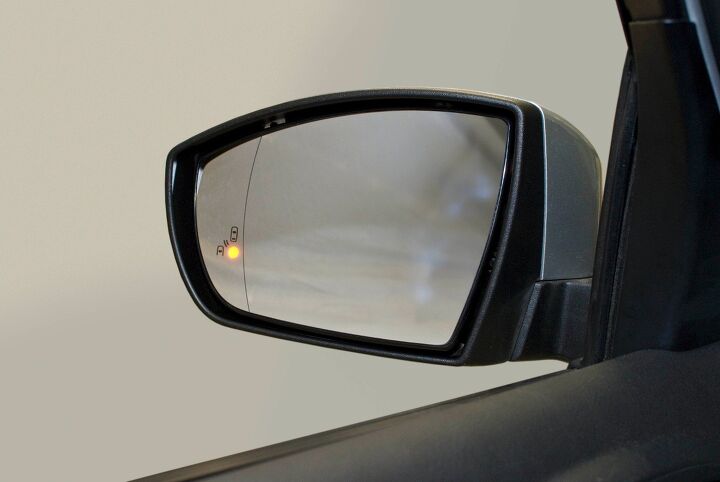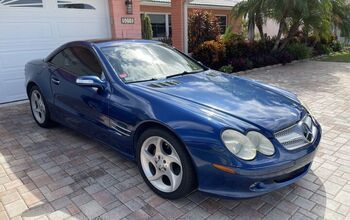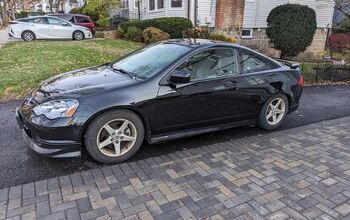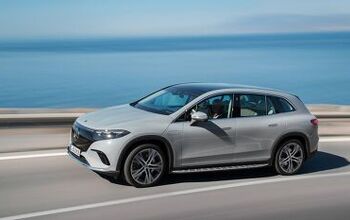Lane Departure Warnings, Blind Spot Alerts (Probably) Reducing Crashes: Study

Lane departure alerts and blind spot monitoring systems can significantly reduce crashes if consumers use the features, according to two recent studies by the Insurance Institute for Highway Safety. While this information falls into the no-brainer category, rarely do we get specific metrics on these particular technologies.
“This is the first evidence that lane departure warning is working to prevent crashes of passenger vehicles on U.S. roads,” explained Jessica Cicchino, IIHS vice president for research. “Given the large number of fatal crashes that involve unintentional lane departures, technology aimed at preventing them has the potential to save a lot of lives.”
One reason there isn’t a lot of data on the effectiveness of the technologies is because it’s so difficult to quantify accidents that don’t take place.
Mixing up correlation and causation is a pitfall researchers perpetually have to avoid. The evidence of things not seen is inherently troublesome and the IIHS study may suffer from a bit of the old “magic rock” fallacy. If you’re unfamiliar with the concept, The Simpsons tackled it in 1996 when Lisa alleges the town’s expensive Bear Patrol may have nothing to do with why there are no bears.
However, while we should keep this in mind as we examine the stats, it isn’t meant to undercut the inherent usefulness of lane departure or blind-spot alerts. Some warning is always better than no warning at all when you’re absent minded behind the wheel.
Using previous studies and data from police-reported crashes, the IIHS concluded that systems that warn drivers when they’re beginning to drift out of their lane reduce injuries by 21 percent and total collisions by 11 percent. Cicchino believes the technologies could have prevented nearly 85,000 crashes and 55,000 injuries in 2015, had they been installed on all vehicles at the time.
Similarly, IIHS found blind-spot detection systems cut the chances of lane-changing crash injuries by 23 percent and total accidents by 14 percent. However, a 2015 study of lane departure warnings in U.S. truck fleets found the technology cut the rate of relevant crashes nearly in half, and an analysis by Volvo cars in Sweden found a reduction of relevant injury crashes of 53 percent.
While particularly alert drivers probably have a less-than-dire need for such systems, they are useful. A little light that tells you when a car might be just behind your rear fender is indeed a handy item. Likewise, everyone can benefit from lane departure warnings after a few brain-dull hours spent on the expressway.
Research from the Highway Loss Data Institute backs up the IIHS claims, suggesting the injury rate could be lessened by up to 86 percent. However, the IIHS claims the HLDI hasn’t uncovered direct benefits in the form of lower claim rates from lane departure warnings — primarily because lane departure is typically bundled in with other safety systems that could skew the data.
In the most recent IIHS study, Cicchino included vehicles with optional lane departure warning from six manufacturers: General Motors, Honda, Mazda, Mercedes-Benz, Subaru, and Volvo. Automakers provided information about the presence of optional features on specific vehicles (via vehicle identification numbers) and researchers used 2009 through 2015 crash data from states that provided VINs of the cars involved, making it possible to identify the vehicles and determine if they had lane departure warning systems or not.
You can make up your own mind as to how accurate the estimates are. In the meantime, both institutes feel that implementing the safety features on more vehicles would save lives and significantly reduce accident rates. “Most of these kinds of technologies started out being optional equipment on the highest trim level on the most luxury vehicles. It’s starting to filter down more but it still hasn’t filtered down all the way,” Cicchino said.
Cost is the largest factor, according to a the Alliance of Automobile Manufacturers. “While the industry is proud of these innovations, and eager to see customers embrace these advancements, it’s important that consumers be able to decide how best to spend their safety dollars on these technologies,” an AAM spokesperson said in a statement. “Determining which features are right for their families is a decision best left for consumers.”
[Image: Ford Motor Co.]

A staunch consumer advocate tracking industry trends and regulation. Before joining TTAC, Matt spent a decade working for marketing and research firms based in NYC. Clients included several of the world’s largest automakers, global tire brands, and aftermarket part suppliers. Dissatisfied with the corporate world and resentful of having to wear suits everyday, he pivoted to writing about cars. Since then, that man has become an ardent supporter of the right-to-repair movement, been interviewed on the auto industry by national radio broadcasts, driven more rental cars than anyone ever should, participated in amateur rallying events, and received the requisite minimum training as sanctioned by the SCCA. Handy with a wrench, Matt grew up surrounded by Detroit auto workers and managed to get a pizza delivery job before he was legally eligible. He later found himself driving box trucks through Manhattan, guaranteeing future sympathy for actual truckers. He continues to conduct research pertaining to the automotive sector as an independent contractor and has since moved back to his native Michigan, closer to where the cars are born. A contrarian, Matt claims to prefer understeer — stating that front and all-wheel drive vehicles cater best to his driving style.
More by Matt Posky
Latest Car Reviews
Read moreLatest Product Reviews
Read moreRecent Comments
- ChristianWimmer This would be pretty cool - if it kept the cool front end of the standard/AMG G-Class models. The front ends of current Mercedes’ EVs just look lame.
- Master Baiter The new Model 3 Performance is actually tempting, in spite of the crappy ergonomics. 0-60 in under 3 seconds, which is faster than a C8 Corvette, plus it has a back seat and two trunks. And comparable in weight to a BMW M3.
- SCE to AUX The Commies have landed.
- Arthur Dailey The longest we have ever kept a car was 13 years for a Kia Rondo. Only ever had to perform routine 'wear and tear' maintenance. Brake jobs, tire replacements, fluids replacements (per mfg specs), battery replacement, etc. All in all it was an entirely positive ownership experience. The worst ownership experiences from oldest to newest were Ford, Chrysler and Hyundai.Neutral regarding GM, Honda, Nissan (two good, one not so good) and VW (3 good and 1 terrible). Experiences with other manufacturers were all too short to objectively comment on.
- MaintenanceCosts Two-speed transfer case and lockable differentials are essential for getting over the curb in Beverly Hills to park on the sidewalk.


































Comments
Join the conversation
How much does this feature normally cost? I have provided the service a few times this year free of charge, by laying on my horn when some idiot starts merging into my lane as I'm passing him. I should send them an invoice.
Surprising to me how many people on this site appear not to set their mirrors properly so as not to have blind spots. I would expect that from the general population but not on an automobile enthusiast website. On probably 9 out of 10 vehicles (I concede there are exceptions - most of which I would imagine are vehicles with narrow fields of vision out the rear window), if you set your mirrors correctly, there is no blindspot and no need to shoulder check (which is an inherently dangerous activity), and whenever you look over and see that blind spot monitoring light on in the mirror, you'll also be looking at the thing supposedly in your "blind spot."